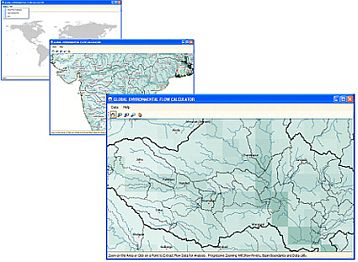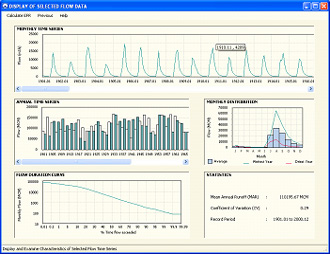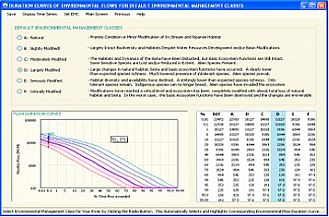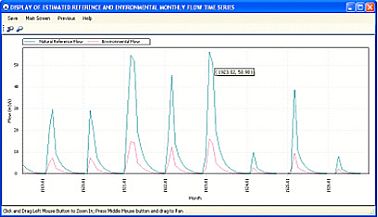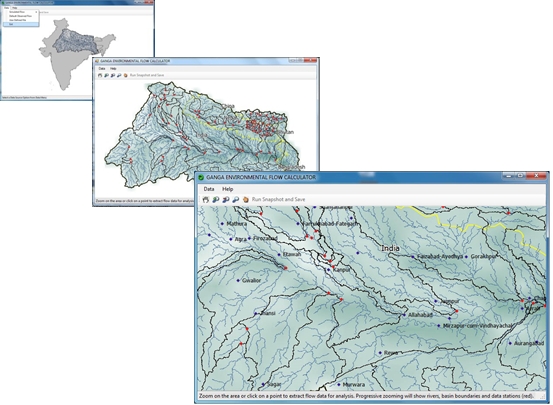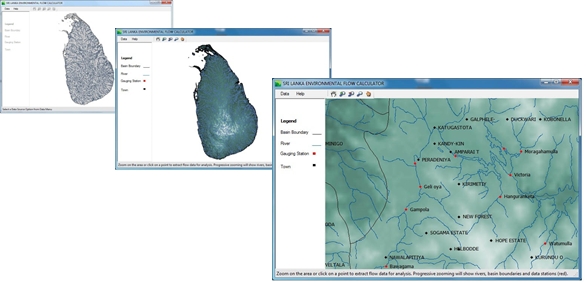| Environmental Flow Calculators |
| Global |
| Ganga (Ganges) |
| Sri Lanka |
| Western Nepal |
The IWMI Environmental Flow Calculators are a family of software for desktop rapid assessment of Environmental Flows (EFs). The EF estimation technique employed in the calculators uses monthly time series reflecting “natural” / unregulated flow conditions and its corresponding Flow Duration Curve (FDC) – a cumulative distribution function of flows. The FDC is represented by 17 percentage points on the probability (X) axis. EFs aim to maintain an ecosystem in, or upgrade it to some prescribed or negotiated condition – “Environmental Management Class (EMC).” The higher the EMC, the more water is needed for ecosystem maintenance and more flow variability needs to be preserved.
Six EMCs are used in the calculators ranging from “Unmodified” to “Critically Modified.” Each EMC is represented by its unique FDC. The FDC for each class is determined by the lateral shift of the original reference FDC to the left along the probability (X) axis by one percentage point. Each EMC is effectively an EF scenario. The EMC best suited for the river in question may be selected-based on expert judgment. A FDC established for each EMC can be converted into an EF time series. Details of the method are described in Smakhtin and Anputhas (2006). There are three calculators in this family, which are coded in Visual Basic. All calculators profess a user-friendly interface including a detailed “Help” facility.
Global Environmental Flow Calculator
The Global Environmental Flow Calculator (GEFC) is a software package facilitating rapid assessment of EFs in major rivers of the world. The EF estimation procedure consists of four steps:
Select a Data Source
Two options are available for selecting a data source: The “User Defined File” and the “Global Flow Database”. The first option performs all further calculations using a flow time series data file (in a specified text format) provided by the user. The “Global Flow Database” option provides access to a built-in simulated global flow database supplied with the package as default hydrological data. These data are monthly discharges (in m3/s) at a resolution of 0.5 degree across the globe. Each 0.5X0.5 degree cell in the grid holds discharge time series for the catchment upstream of that particular cell. Each time series spans a period of 100 years (from 1901 to 2000). A powerful and user-friendly map interface acts as the gateway to the database and allows the selection of a source time series for any part of the world to be made by clicking on a point (nearest grid cell) of interest. Progressive zooming on the map will expose individual data cells and several global GIS layers (Figure 1(a)).
Display Hydrological Characteristics
Once a user defined file or a grid cell with data is selected, the main hydrological characteristics of the selected flow time series will be displayed on a new screen (Figure 1(b)). The displayed hydrological characteristics include: monthly time series, aggregated annual time series, monthly flow distributions (long-term average as well as for the driest and wettest years in the available record), a period-of-record FDC and some basic flow statistics.
Calculate EFs
The GEFC calculates the FDC for natural reference condition and for each EMC subsequently, plotting them all on the same screen (Figure 2(a)). In addition, flow values corresponding to the 17 fixed percentage points are tabulated. The user can select the most suitable EMC for the river in question, or examine the implications of different EMCs on EFs.
Display Estimated Reference and Environmental Monthly Flow Time Series
Monthly flow time series from selected FDC are generated using a non-linear spatial interpolation procedure, developed earlier. Both the reference and environmental flow time series are displayed in an interactive graph with facilities for panning and zooming (Figure 2(b)).
Figure 2 (a) The graphed and tabulated Reference and Environmental Flow Duration Curves (b) Display of Estimated Reference and Environmental Flow Time Series
GEFC is a product of a collaborative project between IWMI and the Water Systems Analysis Group of the University of New Hampshire (UNH – http://www.wsag.unh.edu/).
The Procedure, as described above, has also been incorporated into WEAP Model of the SEI.
Ganga (Ganges) Environmental Flow Calculator
The Ganga Environmental Flow Calculator is a software package for rapid assessment of EFs in different locations of the Ganga basin, India. The EF estimation procedure is similar to that of the GEFC. The user interface in the Ganga Environmental Flow Calculator consists of GIS layers only of the Ganga Basin (Figure 3). It has three source data options named the “User Defined File, Simulated Flow” and “Default Observed Flow”. The “User Defined File” option performs all further calculations using a flow time series data file (in a specified text format) provided by the user. The “Simulated Flow” option currently provides access to flow time series at different locations of the Ganga basin, simulated by the hydrological models SWAT and WEAP. The “Default Observed Flow” option is for the provision of observed flow time series. However, this option is not functional at present.
Figure 3 The illustration of progressive zooming in the Ganga Environmental Flow Calculator from the main screen to the individual river basins and data locations (in red) seen at a higher zoom level.
Sri Lanka Environmental Flow Calculator
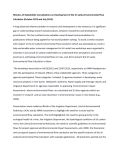
The Sri Lanka Environmental Flow Calculator is a software package facilitating rapid assessment of EFs in major rivers of Sri Lanka. The EF estimation procedure is similar to that of the GEFC. However, the user interface in the Sri Lanka Environmental Flow Calculator consists of GIS layers only of Sri Lanka. It has three source data options named the “User Defined File, Simulated Flow” and “Default Observed Flow”. The “User Defined File” option performs all further calculations using a flow time series data file (in a specified text format) provided by the user. The “Simulated Flow” option is for the provision of simulated flow time series. However, this option is not functional at present since the underlying database has not been populated with simulated flow data yet. The “Default Observed Flow” option is for the provision of “naturalized” observed flow time series. Currently this option allows extraction and use of observed raw data (supplied by the Irrigation Department and the Mahaweli Authority of Sri Lanka) since “naturalization” of data at all locations is still in progress.
Figure 4 The illustration of progressive zooming in the Sri Lanka Environmental Flow Calculator from the main screen to the individual river basins and data locations (in red) seen at a higher zoom level.
Western Nepal Environmental Flow Calculator
The Western Nepal Environmental Flow Calculator (WENEFC) is a software package for desktop assessment of Environmental Flows (EF) of the Karnali-Mohana and Mahakali Rivers in Western Nepal. It was developed by incorporating simulated monthly flow values at 157 locations on both rivers. The simulated flows are outputs of Soil and Water Assessment Tool (SWAT) hydrological models. Two methods were developed to estimate EF, the Hydrological Method based only on hydrological considerations and the Holistic Method based on hydrology as well as ecology and socio-cultural considerations. The Hydrological method follows the procedure developed by Smakhtin and Anputhas (2006), whereas the Holistic method is based on results from ecological and social surveys conducted under the Digo Jal Bikas project. Both Hydrological and Holistic Methods estimate EF requirements to maintain the rivers in different management categories, ranging from “pristine” to “highly modified.”
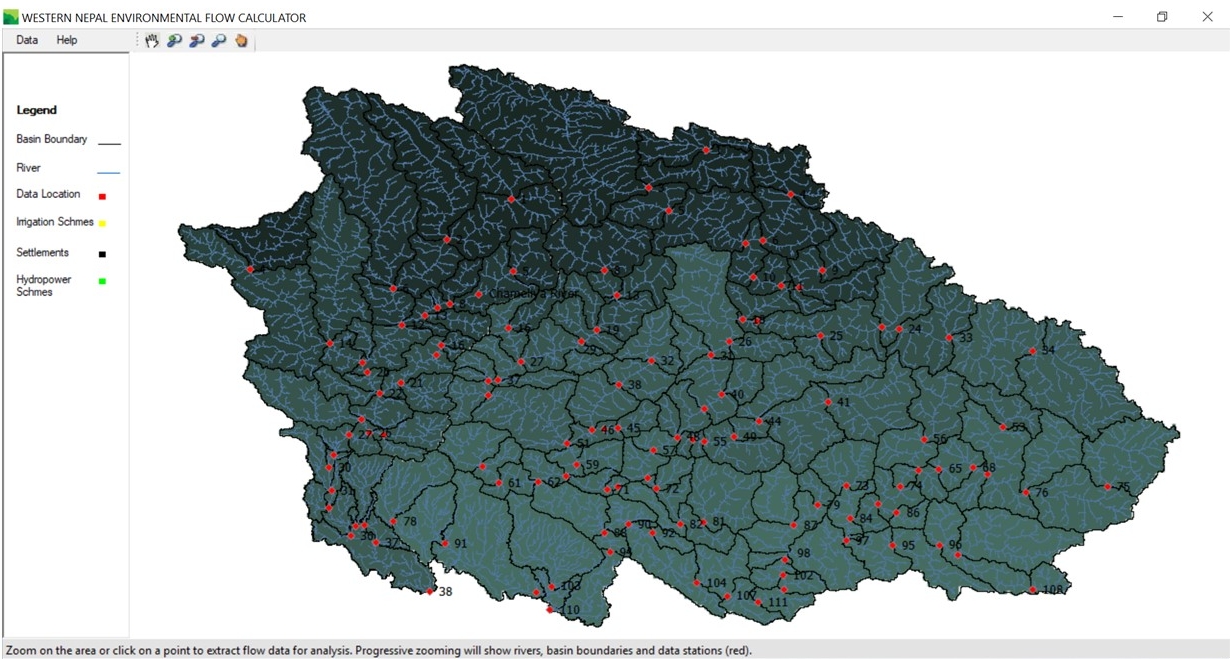
A free copy of any of the software may be downloaded from the “Downloads” tab on this page. Please contact Dr. Nishadi Eriyagama (n.eriyagama@cgiar.org) for any inquiries.


